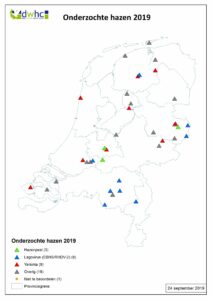Reappearance of tularaemia in the province of Utrecht
In September 2019, tularaemia was again confirmed in a hare on the territory of the Wildlife Management Unit ‘Kromme Rijn’ in the province of Utrecht. A few hares died in this area in previous years due to tularaemia.
Rabbit fever
The bacterial disease tularemia, caused by Francisella tularensis is also known as rabbit fever. This disease can occur in many animal species, but hares and rodents are in particular sensitive to it. Humans can also become ill due to the bacteria. Tularaemia is a zoonosis, which means that humans can get the disease through contact with an infected animal. In addition, humans can also become infected via an insect or tick bite, via ingesting contaminated (surface) water or food or via inhaling contaminated dust or air particles. Information about the symptoms of this disease in people is available on the websites of the European Centre for Disease Prevention and Control and Centres for Disease Control.
The cause of death of hares
If a dead hare is found, it is often thought that the animal died of tularaemia, but in most cases there seems to be a different cause of death. In the period 2013 to this day, 335 hares were submitted for post-mortem exam to the DWHC, and in 40 hares tularaemia was detected. People automatically thinking the cause of death must be tularaemia, may be the result of the attention for this disease. This attention is caused by the fact that tularaemia is a zoonosis and people should take the necessary precautions (see paragraph below) to reduce the risk of infection. Table 1 shows per province and per year the number of hares diagnosed with tularaemia.
Table 1: Overview of the number of hares with tularaemia in the period 2013 – until now
| Rabbit fever | 2013 | 2014 | 2015 | 2016 | 2017 | 2018 | 2019 | Total |
| Groningen | 1 | 1 | ||||||
| Friesland | 12 | 1 | 13 | |||||
| Overijssel | 1 | 2 | 1 | 4 | ||||
| Gelderland | 1 | 1 | 2 | |||||
| Utrecht | 1 | 5 | 3 | 5 | 1 | 15 | ||
| Zuid-Holland | 1 | 1 | ||||||
| Zeeland | 1 | 1 | ||||||
| Limburg | 1 | 1 | 1 | 3 | ||||
| Total | 1 | 2 | 14 | 8 | 4 | 8 | 3 | 40 |
In most cases, the hares did not suffer from tularaemia but were other causes of death identified. Taking the animals examined at the DWHC in 2019 into account, most hares had died of the Yersinia bacterium or the lagovirus (EBHS and/or RHDV-2), see figure 1.
Further information
Tularaemia
the DWHC website.
Human disease: the European Centre for Disease Prevention and Control and Centres for Disease Control.
Animals: Tularemia findings in 2015 – WUR and https://www.wur.nl/nl/Onderzoek-Resultaten/Onderzoeksinstituten/Bioveterinary-Research/Dierziekten/Bacteriele-ziekten/Tularemie-hazenpest-1.htm (in dutch)
Yersinia
Dutch website: https://www.dwhc.nl/en/diseases/yersinia-pseudotuberculosis/
Lagoviruses RHDV-2 and EBHS
DWHC website: Viral Hemorrhagic Syndrome
European Brown Hare Syndrome




